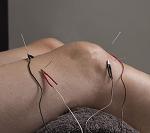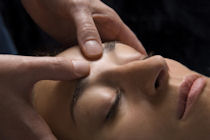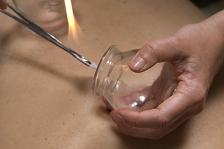For many patients, acupuncture alone is all the treatment that they need. However, sometimes it is necessary to supplement the needles with other techniques to get the full benefits of treatment.
| Electroacupuncture
 I tend to use electroacupuncture in circumstances where strong manual needle manipulation might be used by some practitioners. I find electroacupuncture more comfortable for patients and more effective than such strong needling. I tend to use electroacupuncture in circumstances where strong manual needle manipulation might be used by some practitioners. I find electroacupuncture more comfortable for patients and more effective than such strong needling.
Electroacupuncture is quite similar to manual acupuncture in that the same points are stimulated during treatment. As with manual acupuncture, needles are inserted on specific points along the body. The needles are then attached using small clips to a machine that generates continuous electric pulses. Electroacupuncture uses two needles at time so that the impulses can pass from one needle to the other. Several pairs of needles can be stimulated simultaneously, usually for no more than 30 minutes at a time.
According to the principles of traditional Chinese medicine, illness is caused when the body’s energy does not flow properly. Acupuncturists determine whether this energy is weak, stagnant or otherwise out of balance, which indicates the points to be stimulated. Electroacupuncture is considered to be especially useful for conditions in which there is an accumulation of energy, such as in chronic pain syndromes, or in cases where the energy is difficult to stimulate.
Massage
 Massage can be an effective addition to needling, to relax tense muscles, but also to stimulate specific meridians or individual acupuncture points, to enhance the effects of the needles. Massage can be an effective addition to needling, to relax tense muscles, but also to stimulate specific meridians or individual acupuncture points, to enhance the effects of the needles.
Sometimes applying pressure to stimulate a point prior to needling can make the sensation that the patient experiences more pleasant and lead to a better outcome.
Cupping
 Cupping is a method of applying acupressure by creating a vacuum next to the patient’s skin. The therapy is used to relieve what is called “stagnation”, and is used in the treatment of respiratory diseases such as the common cold, pneumonia, and bronchitis. Cupping is also used to treat back, neck, shoulder, and other musculoskeletal pain. Cupping is a method of applying acupressure by creating a vacuum next to the patient’s skin. The therapy is used to relieve what is called “stagnation”, and is used in the treatment of respiratory diseases such as the common cold, pneumonia, and bronchitis. Cupping is also used to treat back, neck, shoulder, and other musculoskeletal pain.
Cupping can leave marks on the skin for several days after treatment. |